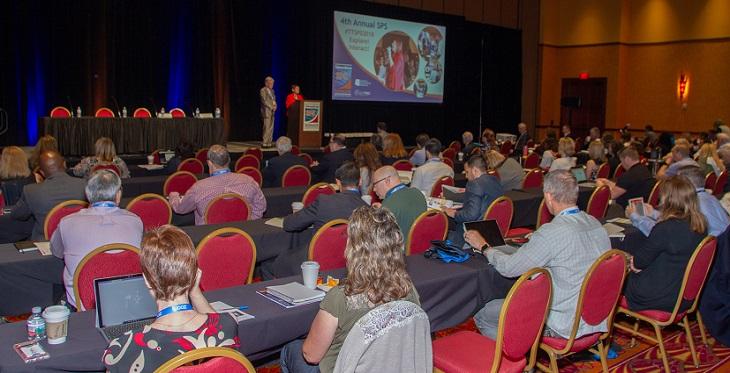
The 4th Annual Telemedicine & Telehealth Service Provider Summit (SPS https://ttspsworld.com/), sponsored by the Arizona Telemedicine Program (ATP) and Southwest Telehealth Resource Center (SWTRC), was held October 8-9 in Glendale, AZ, and attracted an all-time high of nearly 400 attendees! SPS continues to be unique in its intent to bring together telemedicine service providers and users in a collaborative and interactive venue that provides the opportunity to learn from each other. SPS, as in past years, was organized and hosted by Drs. Dale Alverson, Elizabeth Krupinski, and Ronald Weinstein. The ATP team contributed innumerable hours (especially Nancy Rowe and Kris Erps), support, and enthusiasm to put the meeting on and deserves many kudos and thanks (Cassandra Coray, Ellen Dudzik, Kris Erps, Mike Holcomb, Angel Holtrust, Bob Kerr, Janet Major, Chris Martin, Karen Miller, Nancy Rowe, Tracy Skinner)!
.jpg)
What did attendees say about the benefits of the Summit? “Hard to say – it was all great!” “Lessons learned.” “Real-life examples of successes and pitfalls with telemedicine.” “Networking.” “Exceptional speakers – all of them.” “Breadth of topics.” “Meeting the vendors and learning about what each of them can bring to the table.” “Love lightning rounds.” “Lots of great resources and variety of information.” “Having all vendors in one place.” “Hearing from leaders who are doing telemedicine in some fashion.” These are just a few of snippets of feedback received.
It’s impossible to summarize the full content and impact of this exciting and information-packed meeting (https://view.joomag.com/sps-2018-program-sps-2018-program/0073473001538770275?short) but here are a few of the key take-away points from the talks and panels, whichfeatured world-renowned speakers from all health and telehealth sectors (https://ttspsworld.com/speakers).
- Partnerships are becoming increasingly diverse, even in a consolidating market.
- Legislative, regulatory, and reimbursement barriers are falling, but it’s still critical to keep on top of the changing landscape.
- Quality care and metrics for measuring telehealth impact are essential.
- Keys to success are people, training, and workflow integration.
So – what were my favorite sessions? I must admit that my scientist hat ruled and they were “Proving Your Case with Quality Metrics & Cost Data” and “Navigating the Rapids of Changing Telehealth Tech.” The first session was a panel with Najib Ben Brahim, PhD, from Ignis Health, Kelly Ko, PhD, from West Health, and Arnab Nayak, PhD, from Mercer University. All are experts in the analysis of telehealth data from different perspectives and addressed a series of related questions, ranging from, how to prove your case and what to concentrate on from the metrics perspective if you’re just starting down the telehealth road and want to make your case, to what is the necessary balance between rigor (lofty/long-term research data) and expediency (practical/short-tem data for decision making) and are we moving too slowly?

All panelists agreed that metrics are important – from the scientific, financial, and administrative perspectives. There was also clear agreement that metrics need to be considered in advance of program initiation. Their overall best advice: Start small and with a solid but limited set of metrics that all stakeholders agree are relevant to the program’s mission and strategic plan. Data should also be readily acquirable so there are no undue pressures on team personnel during the data collection process. It was noted that a good place to start when selecting which metrics to use is the National Quality Forum’s 2017 Telehealth Framework Document.
It was interesting that the other question received mixed responses. On the one hand, all agreed that we certainly need more data sooner than later (although it was also noted that we already have more data than most people realize!) to improve the regulatory, legal, and reimbursement landscapes. However, some were more of the opinion that basic research with well-controlled randomized studies is still and should be the gold standard in order to “prove” the benefits of telemedicine. Others felt that randomized controlled trials, while the ideal, are simply not practical or efficient for demonstrating positive outcomes in a timely manner to change and alleviate current barriers. A follow-up question asked the panelists to pick one answer to the following question: Should we concentrate more on clinical outcomes or financial cost-related study metrics? Although there was some hemming and hawing and trying to pick both, in the end all agreed that to convince most stakeholders, it’s the data supporting the financial benefits of telehealth that will have the most impact.
For the “Navigating the Rapids of Changing Telehealth Tech” breakout track, come on, who isn’t excited about gizmos, gadgets, and super-cool technology?! This session was part of a new direction for SPS–a full afternoon composed of three dedicated tracks on special topics. Speakers in this track were: Scott Simmons, MS, from Medweb talking about Real Healthcare Benefits of Augmented Reality; Veena Misra, PhD, from North Carolina State University, speaking onWearable Sensors & Health Outcomes; Alexis Silver, MBA, from Alexis Silver Consulting, discussing Partnering with your Telehealth Vendor; and myself talking about AI & Telehealth.
Augmented reality (AR) isn’t just for gamers! And let’s face it: The closer we get to what Star Trek’s Dr. McCoy was able to do, the better (and cooler) healthcare will be. According to Scott, AR has immense value in pre-hospital care, for example in victim face ID, monitoring associated with ID, mentoring, and mass casualty triage. Intraoperatively it can be used for remote guidance (e.g., during surgery), telestration, monitoring/alarms, and surgical pathology review. Lots of work still needs to be done and the headgear isn’t always the most practical for real-life use, but it is out there being used and will obviously continue to improve and find a role in healthcare.
Wouldn’t it be fantastic if you could just stick a sensor on your arm and have it record all your vital information, analyze it, send it to your healthcare provider, and prompt them to intervene if your health status is about to change for the negative? That’s what I want! Veena presented an overview of the amazing technologies her lab is developing that will do just that, and more! The innovative and exciting feature they are working on is that these devices will be self-powered—no no batteries, no waving your arms around to charge them. They literally draw their energy from the human body’s electro-magnetic field. These types of devices, once perfected, will, I predict, become pervasive throughout the world (as the cost and maintenance will be rather low) and used to monitor both healthy people and those with chronic and acute conditions.
To make both augmented reality and wearable sensors effective and efficient, artificial intelligence (AI) must be integrated into their programming and data analysis pipelines. I summarized the wide variety of application areas and companies not only using, but actively promoting their use of AI in their healthcare platforms and data-analysis tools. Where can AI help? One clear application is in the analysis of the massive amounts of data remote patient monitoring and other sensor-based technologies collect. These data are useless if providers cannot make any sense out of them or if they yield too many false alarms to be tolerated by both patients and providers. AI can help in many ways: establish “normal,” baseline data values for an individual; integrate data from multiple sources to determine under what circumstances data are being collected (e.g., is someone’s heartrate changed because they are having a heart attack or because they are running); produce alarms based on population as well as individual level statistics and trends; and a host of other applications. Should providers worry that AI will take over their jobs? I say resoundingly NO! AI will be a clear help in condensing data into meaningful units, providing second opinions via clinical decision support, and helping triage patients to different levels of care and places to go for care by assessing not only patient data but workflow and provider availability and expertise data.
Navigating technology from the user perspective is a challenge: What on earth do you invest in and how to choose from all the options? Alexis provided some great information and then went through an exercise using a weighted checklist tool to prioritize/allocate which variables to consider in your decision-making process. Key advice: Really think about your mission and goals before you start deciding what the “must have’s,” “maybes,” and “would be nice but not critical” features of your tech solution are. Being organized, proactive, and goal-driven will help you in your tech choices.
A key theme throughout these two and other sessions was that telemedicine is not about the technology. However, sometimes the technology really is pretty cool!


